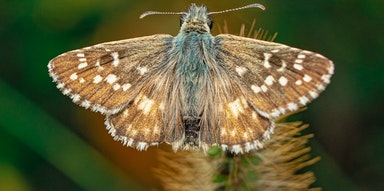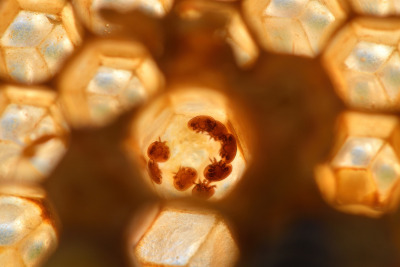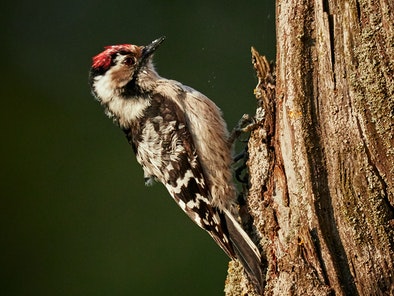Bee pests
Wax moth
Wax moths (Achroea grisella) are very dangerous pests that can completely destroy honeycombs in hives and ultimately devastate an entire bee colony. Moths live only 12 to 15 days, during which time the female can lay 500 to 700 eggs. The eggs are carefully placed in the rot at the base of the hive or in small cracks, most often in parts of the old honeycomb that are blackened and dilapidated. After 5 to 15 days, small, highly mobile larvae hatch from the eggs, causing enormous damage to the honeycombs. If females lay eggs in the fall, they are very resistant and can survive throughout the winter, hatching in the spring when the weather warms up. Larvae can live for 20 to 140 days, depending on the temperature. When the temperature drops below 10 degrees, the larvae stop developing, die, and become immobile, a state in which they can spend several months. When the weather warms up, they begin to develop normally, cocoon themselves, and later transform into butterflies. The larvae destroy the honeycomb cells in which the brood was made.

The fight against the wax moth consists of taking the following measures:
- Keep the hives clean on a regular basis.
- Prevent cracks or rot on the hive floor.
- Replace old honeycombs with new ones.
- If the bee colony is strong, they can defend themselves against the moths.
- Remove excess honeycombs from the hive because they create favorable conditions for moth development when left behind partition boards.
- Melt old honeycomb down as soon as possible because it attracts moths.
- Burn all dirt and debris from the hives and avoid spreading it in the apiary.
- Pay special attention to the storage of frames with empty honeycomb and store them in a closed, dry, and windy room, preferably in the extensions or brood.
- Arrange the frames in the extensions less frequently than usual.
Wasps and Hornets
Wasps cause significant damage to bees. In recent years, they have become a significant danger in some places, and it is crucial to take serious consideration when combating them. Wasps are harmful because they feed on honey, buy larvae from the bee brood, feed their brood with them, and transmit infectious diseases.

There are several ways to control wasps.
- The first is to destroy wasps by sprinkling boiling water.
- Several types of insecticides in the form of sprays can successfully destroy wasps.
- Wasps can also be destroyed by pouring half of beer that has been slightly sweetened into colorless glass bottles.
Hornets are not as dangerous for beekeeping as wasps, but they are still dangerous for bees on pasture. Hornets can be destroyed in the same way as wasps.
Bee Louse

Bee louse is a small insect that lives on bees and greatly disturbs them. They prefer to feed on royal jelly, making them a threat to the queen and young worker bees that produce this substance.
Significant multiplication of bee lice can impede the development of bee colonies, ultimately reducing honey production.
Mice

Mice are very dangerous pests. They are sensitive to bee stings and therefore, during active flight, worker bees prevent them from accessing the hive. But as soon as the bees form a ball, then the mice, if they crawl into the hives, can do great damage because they bite the honeycombs and eat the honey, disturb the bees, etc. They often make their nests in the hive and breed there. That a mouse is in a hive can be detected by its feces or the constant buzzing of bees. The most effective fight against mice is to put combs (grids on the flight of the hive) when the bees are dormant, which will prevent them from entering the hive. This grid is placed in the summer only at the time when the bees are dormant, that is, as soon as the bee colonies start to warm up and prepare for the winter. However, if the mouse has already crawled into the hive and settled there, then the bees should be moved to another hive.
Birds

Little is known that a number of birds attack bee societies and feed on them. The most dangerous are woodpeckers, woodpeckers, and budgies. Sometimes bees are attacked by chickens, turkeys, and guinea fowls, usually in the growth phase, i.e. when they are neither chickens nor adult chickens.
All the mentioned animals and some other birds find it difficult to catch and eat live worker bees because they sting them in the area of the oral part. The biggest mistake is if some beekeepers, when cleaning the hive, throw dead bees around beehives, which attracts birds and animals. When they eat them, they catch drones, which do not sting, and also live worker bees.
In winter, when it snows, the birds find it difficult to find food and then land in the hives and eat dead bees, and then peck in the hive, disturb the bees, which fall from the ball to the bottom stand, so if they manage to get out through the entrance reducer, the birds catch them. If it is very cold, they stiffen as soon as they fall off the ball.
Some birds catch bees in flight. Among them are the most dangerous swallows, which sometimes fly in a flock above the beehives, waiting for the bees to leave or return from the pasture, catching them, and eating them. The greatest damage is if the queen is killed by birds during the flight to the wedding flight. It has been observed that sparrows also attack bees, but primarily males. The sparrow catches a live bee, flies with it to a tree and keeps it in its beak for a long time until the bee dies. He then lowers it to the ground, tears it into smaller pieces, and eats it.
To protect bees from domestic animals, it is essential to fence off the apiary. While inspecting the colonies and cleaning the hive, including the floor, always use a suitable container to collect all the dirt and dead bees. After the inspection, ensure that the dirt and dead bees are either burned or buried in the ground, at least half a meter deep. This measure is essential to prevent the spread of diseases and pests. It's also necessary to collect dead bees more often, especially during the winter, from the take-off board. During spring and summer, it's crucial to break the nests of birds in the area. In critical periods, wind alarms can help to scare them away. However, if the birds are useful, take measures to prevent them from catching live bees. In winter, hang a basket with food a little further from the apiary so that birds don't need to attack bees. Remember, under no circumstances should useful birds be destroyed.
Wax moth Wasps Bee louse Mice Birds arrow_upward